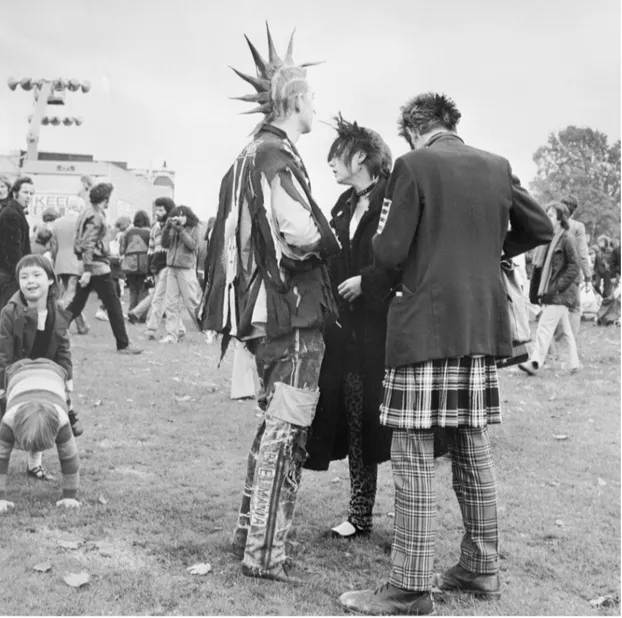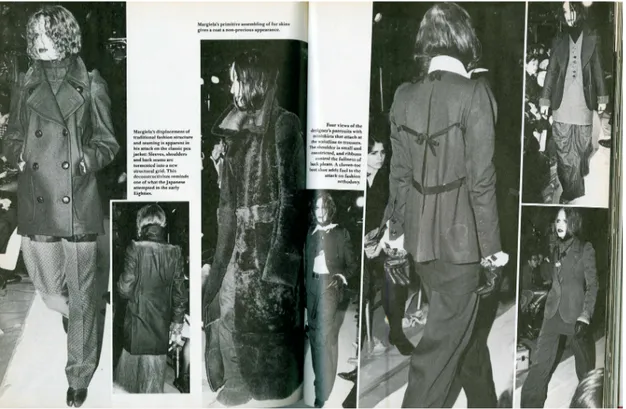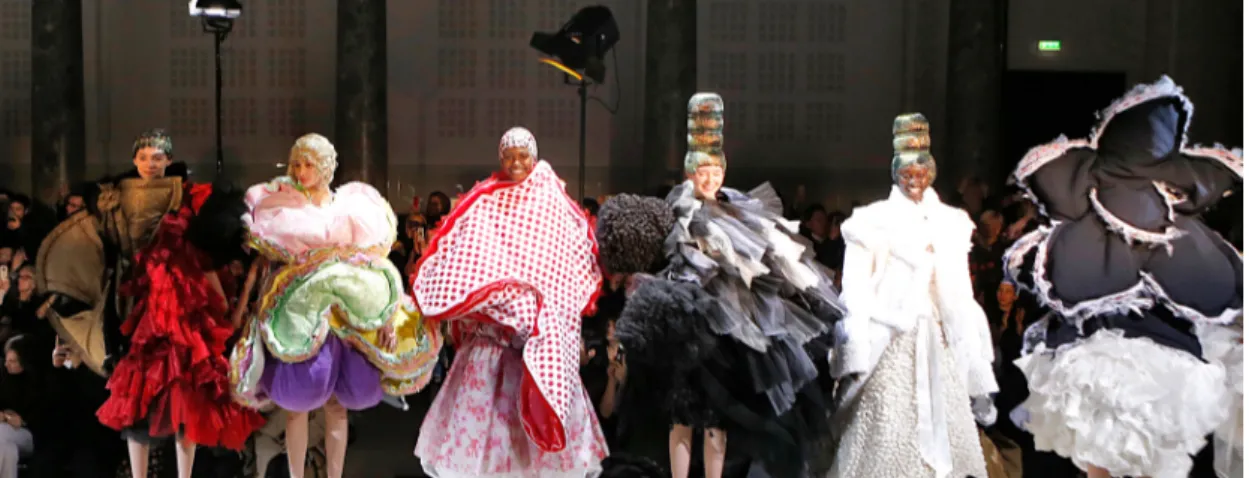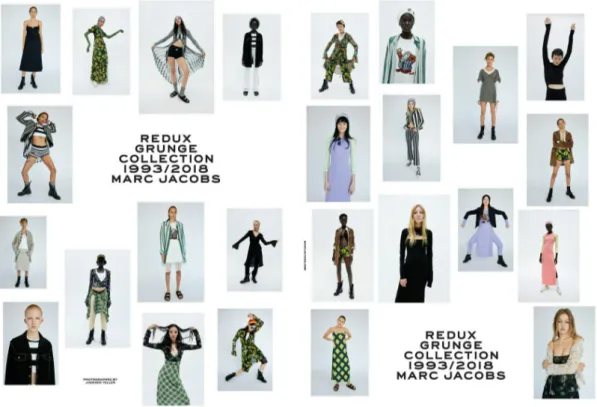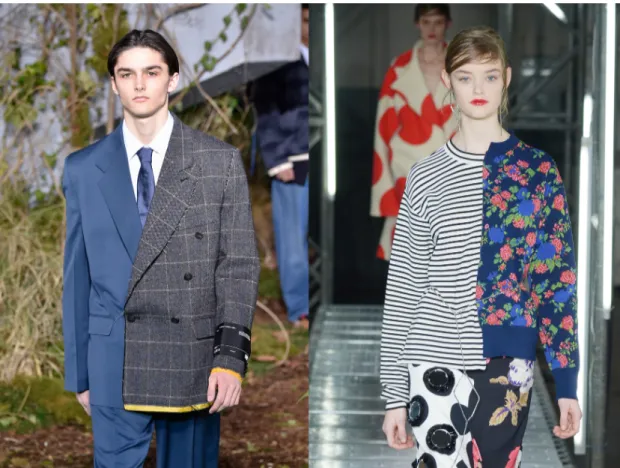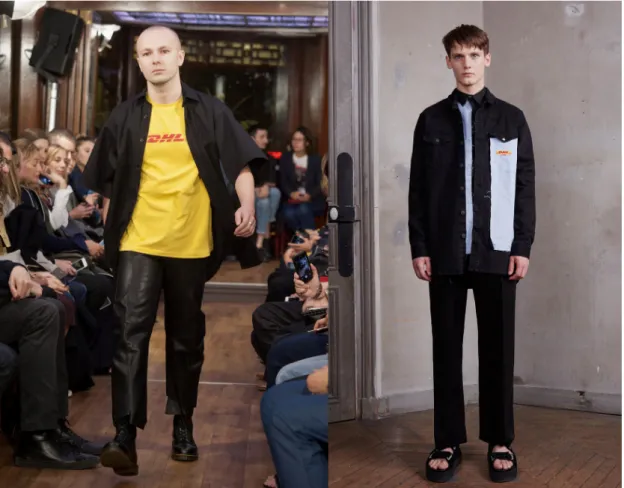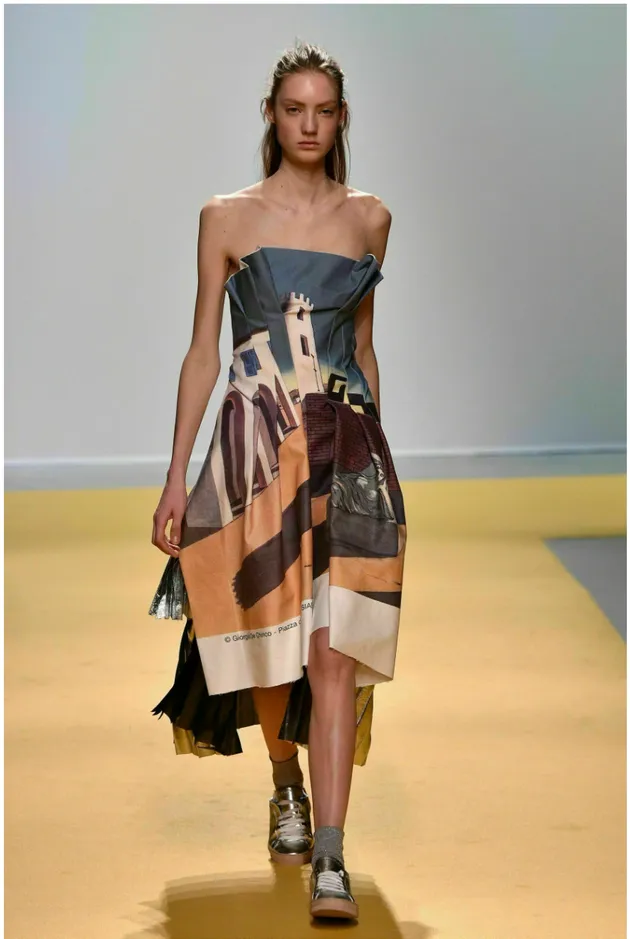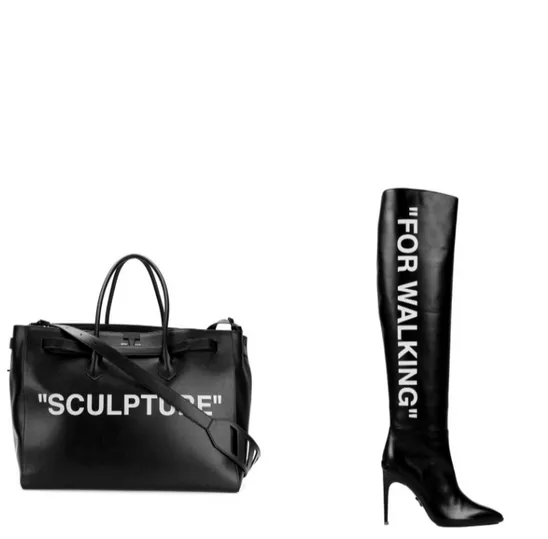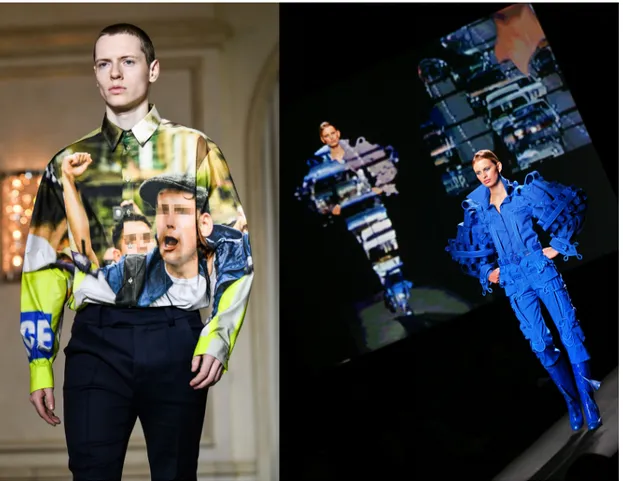Fading, Mixing, Slicing, and Looping:
the Deconstruction of Fashion Through the Creative
Process of Music
Vittorio Linfante
* Published: July 29, 2020Abstract
Fashion as mirror of socio-cultural evolutions. In light of the ever-increasing plurality and hybridiza-tion of languages, fashion change, through disassembling and reconstruchybridiza-tion achybridiza-tions according to creative processes capable of generating new design approaches. The creative process, having passed the phase of revival, rediscovery and re-proposal of styles, today acts more and more according to an approach far from citationism. A method that deconstructs and reassembles products, materials and styles, in a mash-up, generating new signs, meanings and shapes, that recall, but do not refer di-dactically to precise references. Shapes, symbols, textures are thus deconstructed and recomposed according to logics and approaches that generate a multiplicity of meanings.
Brands such as Vetements, Off-White, United Standard, Marcelo Burlon borrow from music not only cultural references but also a design approach. There is a form of deconstruction that looks more like a music mix using techniques such as Fading, Harmonic Mixing, Slicing, Swap or Looping. Thus a new identity of contemporary fashion takes shape: we witness to a meta-design process that, thanks to a group of emerging figures hovering between DJs and fashion designers, defines an idea of decon-struction according to approaches that owe much to consoles, mixers, and synthesizers.
Keywords: Deconstruction; Design processes; Creative industries; Fashion Branding; Music.
* Politecnico di Milano (Italy);[email protected]
Fashion tracks. Creative Discourses between Fashion and Music
Music, according to Patrizia Calefato, represents a social practice that involves others. It can be un-derstood as a complex place of textuality. In this sense, music should be unun-derstood as a process of production of meaning in which the body participates deeply.1 In the same way, we can (and must) interpret fashion. Fashion, in close relationship with the body,2by its very nature is to be considered as a social practice3and as a process of production of meaning and, not least, of creativity. The relation-ship between music and fashion takes different forms as the historical fields and moments vary, defining each time cultural, communicative, market and style connections. Music and fashion indeed build syn-ergies from the creative process point of view; a process that in the contemporary hybrids traditional production processes with new technologies, the physical nature of raw materials and the virtuality of new design tools. If “the advancements in information technology lead to new ways of music creation, production, distribution and consumption.”4 In the same way, also in fashion, we are witnessing the definition of new contaminations that give shape to innovative products, not only because they use new materials or define new aesthetics, but also and above all because they are often the result of creative ap-proaches and processes that are difficult to attribute to a specific field. These new apap-proaches are the result of connections not only between fashion and music,5but also with the world of art, retail,6 mar-keting and production. The project is therefore considered from a relational, holistic, evolutionary and complex point of view.7
Fashion, as a language,8has increasingly enriched the creative discourse with references, cross-references and meanings, creating a process that redefines, deconstructs, disassembles and re-assembles over and over again the relationship between history, production, display and consumption. Fashion as habitus9 gives meaning to the body, thus realizing the concept of the interface10as an expression of social iden-tity, of the fact that wearing a specific dress corresponds to a communicative act.11
Fashion, the dress and the dressed body become elements of an interface,12capable of generating mul-tiple discourses and interactions with the environment and between people in a continuous flow of references, in the real and the virtual space. Flows which define the perception of fashion in constant change. As stated by Ornella Kyra Pistilli, an individual aesthetic that moves between experimentation and research, detachment and disenchantment, cosmopolitanism and cultural hybridizations is thus realized.13
1. Patrizia Calefato, Gli intramontabili. Mode, persone, oggetti che restano (Roma: Meltemi Editore, 2009), 91.
2. Eleonora Fiorani, Moda, corpo, immaginario. Il divenire moda del mondo fra tradizione e innovazione (Milano: Edizioni Polidesign, 2006), 29.
3. Yuniya Kawamura, Fashion-ology An Introduction to Fashion Studies (New York: Bloomsbury, 2004), 14.
4. Jochen Strähle, “An Introductory Viewpoint to Fashion and Music,” in Fashion & Music, ed. Jochen Strähle (Berlin: Springer, 2018), 1.
5. Strähle, 3.
6. For further investigation → see Philipp Teufel and Rainer Zimmermann, Holistic Retail Design: Reshaping Shopping for
the Digital Era (Amsterdam: Frame Publishing, 2015).
7. Giulio Ceppi, “Design dell’esperienza,” in Design multiverso. Appunti di fenomenologia del design, eds. Paola Bertola and Ezio Manzini (Milano: Edizioni Polidesign, 2004), 180.
8. Marshall McLuhan, “La moda è linguaggio,” in McLuhan nello spirito del suo tempo, ed. Nicola Pentecoste (Roma: Ar-mando Editore, 2015), 197.
9. For further investigation → see Pierre Bourdieu, La distinzione. Critica sociale del gusto (Bologna: il Mulino, 1983). 10. Domenico Carzo and Sebastiano Nucera, “Il corpo ri-vestito tra tecnologie e flussi mediali”, Quaderni di Intercultura, VI
(2014): 89. doi10.3271/M25 11. Fiorani, 9.
12. Ornella Kyra Pistilli, Dress code. Sincretismi cultura comunicazione nella moda contemporanea (Roma: Castelvecchi, 2005), 85.
This approach defines a vision of the project, and the creative process that we could say has a lot in common with Jacques Derrida’s thought. A thought that sees fashion as a field of experimentation for talents belonging to different creative areas.
Whether in the order of a spoken or written discourse, no element can function as a sign without referring to another element which itself is not simply present. This interweaving results in each element […] being constituted on the basis of the trace within it of the other elements of the chain or system. this interweaving, this textile, is the text produced only in the transformation of another text. Nothing, neither among the elements nor within the system, is anywhere ever simply present or absent. There are only, everywhere, differences and traces of traces.14
“Traces of traces” which we could consider as the music tracks that in contemporary musical practice de-fine the rhythms that become dance floor hits. “Traces of traces” which are as those present, sometimes as a real citation and sometimes as a cultural reference, in the continuous elaborations and reworking of styles, periods and archetypes that fashion creates. “Traces of traces” which are as those physical ones left on clothes by material and formal manipulations that, since the beginning of the last century, have defined the language of construction and deconstruction of garments. It thus creates a codependence15 between the music industry and the fashion system. Says Janice Miller: “music and fashion marketing are feld by a variety of practical and visual interrelationships in which fashion and style are core to a kind of intertextual taste-sharing between the two industries.”16In this way, a co-dependence between the music industry and the fashion system is defined, which takes different forms in the contemporary consumer society.
Relationships, those between musicians and fashion designers, which are not limited to a relationship in which the former are only testimonials of brands and fashion collections. New links are created in the contemporary world, where we see the fusion of the world of music with fashion, through new forms of entrepreneurship and creativity that see musicians becoming designers and designers becom-ing musicians. As Katie Baron says: “fashion and music are formidable forces: entrancbecom-ing, bewilderbecom-ing, identify-affirming, panic-inducing, tribe-forming, arguably life-saving and indisputably two of the finest playgrounds for indulging creative vision. As such, it rarely gets more exciting than when the two col-lide.”17
Talking about the link between fashion and music unfolds a vast range of relationships, which create in-novatively synergies between the intangible nature of music and the tangible nature of fashion. A link, between the physical nature of fashion and the intangibility of music that finds in music videos an ideal touch point. As Maria Cristina Marchetti and Nello Barile state,18video clips — which are real cul-tural divulgation and aesthetic tools — have represented, and still represent today, the most important medium for the creation of the image of an artist, through the spectacularization of the artist’s image. A spectacularization that makes the performers — as well as the clothes they wear — objects of desire.19 Music videos still represent today a space for aesthetic, formal and technological experimentation. From a pure promotional product, halfway between cinema and advertising, they have increasingly become an independent art form. An artistic form that almost immediately blended with fashion, making it increasingly faster, more consumable and disposable than ever before.20Fashion designers have started using music videos as promotional tools. But also as places to show their creativity through constant
14. Jacques Derrida, Positions (Chicago: University of Chicago Press, 1982), 26. 15. Janice Miller, Fashion and Music (Oxford-New York: Berg Pub Ltd, 2011), 12. 16. Miller, 12.
17. Katie Baron, Fashion + Music. Fashion Creatives Shaping Pop Culture (London: Laurence King Pub, 2016), 8.
18. Maria Cristina Marchetti and Nello Barile, Manuale di comunicazione, sociologia e cultura della moda: Moda e stili (Roma: Meltemi Editore, 2004), 114.
19. Bianca Terracciano, Il discorso di moda: Le riviste femminili dal 1960 (Roma: Nuova Cultura, 2019), 193. 20. Suzy Menkes, “Fashion’s TV Frenzy,” New York Times, 2 April 1996, 47.
collaborations with musicians and singers21as a tool for staging their creative process22or as featuring collaborations.23
The short form of the video clips also shares several characteristics with the fashion world: a high dissi-pative character (both are made available for consumption for limited periods and are replaced by new productions); and an almost unlimited creative freedom that allows to experiment always new technolo-gies and aesthetics.24
Different types of connections that in the historical evolution have defined various opportunities for in-teraction: from the communication one to the decorative one, from the performance one to the creative one. Fashion communication has created a strong partnership, between fashion brands, musicians and singers, that has grown over the years through the language of advertising and fashion photography25 or the creation of collaborations for the production of items or collections in co-edition. The tangible forms of music (notes, sheet music, musical instruments) are also the starting point for the creation of clothes and accessories from Elsa Schiapparelli to Viktor&Rolf have defined some of the most outstand-ing fashion collections since the beginnoutstand-ing of the twentieth-century up to the present day.
Aesthetic imagery conveyed through videos, and live performances are also the starting point for fashion collections. Collections which are practically costumes as in Jean Paul Gaultier’s Spring/Summer 2013 fashion show, which presents on the catwalk almost the same looks and the same outfits of music icons such as David Bowie, Grace Jones, Boy George and Annie Lennox. Ultimately the relationship between music, fashion and body in motion takes shape when choreographers and designers work together to create fashion shows26and dance performances.27But the link between music and fashion does not end here. On the contrary, especially in contemporary music defines a brand new creative process that goes from Vivienne Westwood to Virgil Abhol through Rei Kawakubo and Martin Margiela.
The Sound of Fashion. Music as part of a Fashion Creative
Discourse
Music over the years has generated or stimulated changes, not only of style but also from a social and cultural level.
The evidence of the juncture between fashion, music and dance was marked when Strauss’s music inspired the waltz and gracious nineteenth-century ballroom gowns; when the 1920s jazz provided the tempo to swing the lightweight Charleston-fringed dresses; and when modern south American dancing set the stage of sexually charged, tight-fitting tango gar-21. Since the early days of music video clips, fashion and music have collaborated in many ways, both commercially and
artis-tically. As for example the costumes designed by Stephen Sprouse for Blondie’s “Heart of Glass” (1978), Thierry Mugler for George Michael “Too Funky” (1992), Lady Gaga “Telephone” (2010), and for the costumes of the Beyonce “On The Run II Tour” (2018) and “I Am World Tour” (2009), Jean Paul Gaultier for Madonna “Express Yourself” (1989), Alexan-der McQueen for Lady Gaga “Bad Romance” (2009) and for Björk “Who is It” (2004), Versace for Lady Gaga “Yoü and I” (2011), Alessandro Michele for Björk “The Gate” (2017) and Achille Lauro “Me ne frego” (2020), Iris van Herpen for Björk “Biophilia” (2011), just to name a few.
22. In 1989 Jean Paul Gaultier recorded the single “How to do that”. The video for the launch (directed by Jean-Baptiste Mondino) stages an ironic representation of the French designer’s creative process, in perfect Gaultier style.
23. Several fashion designers have also performed as singers in different music productions. “Something A La Mode” by Rondo Parisiano (feat. Karl Lagerfeld) and Blame it on the Bass line by Saturnino feat. Lawrence Steele, are two examples. 24. Marchetti and Barile, 114.
25. Federica Muzzarelli, L’immagine del desiderio. Fotografia di moda tra arte e comunicazione (Milano: Bruno Mondadori, 2009), 91.
26. Think for example of Rick Owens’ 2014 Spring/Summer show, when hip hop dancers played the US designer’s collection, or Alexander McQueen’s 2004 Spring/Summer show, when professional models and dancers staged a remake of the film
They Shoot Horses, Don’t They?, directed in 1969 by Sidney Pollack and starring, among others, Jane Fonda and Michael
Sarrazin.
27. Consider, for example, the costumes designed by Gianni Versace for Josephs Legende performed in 1982 by Luciana Savignano at the Teatro alla Scala in Milan, or more recently the costumes made by Prada in 2015 for the short film Fallen directed by Kevin Frilet and performed by ten dancers of the Tanztheater Wuppertal.
ments. In the 1930s, musical theatre and Broadway shows extened a great influence on everyday fashion as Rodgers and Hammerstein’s musical scores created a new Hollywood cultural genre with its unique concept of glamour.28
At the beginning of the twentieth century, women were free from the rigid structures of nineteenth-century fashion. They began to wear lighter and less structured clothes “which shimmered and ‘flapped’ with the slightest movement on the dance floor.”29 Simultaneously to the diffusion of jazz music, the structure of the clothes changes: the corsets and meters of fabric that characterized the outfits of the late nineteenth century disappear. Fashion and clothes become a communication media that, over the years, define new forms of clothing through an increasingly close synergy with artistic and musical movements. Subcultures were born, they became increasingly mainstream and established wide niches in global mar-kets.
Clothes sing, records talk, style is language, and genre is affinity. In a moment where digital communication is imperilled, the kids are, all of them right. Fashion and music are the morse code of young people, providing aa system of both signification and organization that is habitually turned into a commercial system of class emblems … Clothes and songs are analogue, even if the source is digital; they both move through physical space before they are captured.30
Space — whether real or virtual, urban, commercial or for entertainment — in which bodies move and music is consumed, becomes the stage for changes in style and endless loops that fashion and music define, in a syncretism between novelty and revival. We witness the coexistence of styles, sounds and attitudes from distant epochs and geographies, but which, in a postmodern way, mix in an aesthetic and cultural melting pot. Subcultures such as Flappers, Zazous, Beats, Bikers, Teddy Boys, Mods, Hip-pies, Punks, B-boys, Metalheads, Skaters, Rappers, Grunge, Ravers, Emos, just to name a few, persist in the contemporary, between nostalgic revival and contamination that take shape through industry, film, music and the fashion system. As Nello Barile states, the proximity of the music and fashion systems has led to a chaotic movement of sharing of signs.31
The boundaries between the two became more and more blurred. For the first time, the boundaries are clearly and definitively demolished by Vivienne Westwood and Malcolm Mclaren who implement in fashion the same creative process which is typical in the punk movement by breaking (of clothes as of melodies), distorting (of volumes as of sounds) and creating chaos (of references and rhythms). A process that made chaos and noise — as punk music was perceived by the establishment — the design vision of the two British creatives.32
We can say, paraphrasing Adam Lowe and Charlotte Skene Catling, that for the two British designers, chaos and noise give shape to their creative act.33 A performative act defines through a process of se-lection and reduction that aims to reveal a pre-existing element. Instead of a method of addition, it is a process of subtraction. An action that involves the finished garment, through operations of destruction, subtraction and recomposition according to an (apparently) random order of elements, materials and artefacts from different backgrounds, social contexts and eras. (Fig. 1) A fusion of elements, confusion of symbols, Do-It-Yourself, disassembly and reconstruction under new forms, become creative actions that characterize for a long time the scene of experimentation both in music and fashion.
28. Bonnie English, A Cultural History of Fashion in the 20th and 21st Centuries: From Catwalk to Sidewalk (London-New York: Bloomsbury, 2013), 85.
29. Stephen Harrison, “American Spirit: The Rhythm of Change,” in The Jazz Age: American Style in the 1920s, ed. Stephen Harrison and Sarah D. Coffin (Cleveland: The Cleveland Museum of Art, 2017), 137.
30. Sasha Frere-Jones, “Inversion,” in Cool, ed. Greg Foley e Andrew Luecke (New York: Rizzoli, 2017), 128.
31. Nello Barile, Manuale di comunicazione, sociologia e cultura della moda. Vol. II. Moda e stili (Roma: Meltemi Editore, 2005), 104.
32. Jon Savage, “Symbols clashing everywhere: Punk Fashion 1975–1980,” in Chaos to Couture, ed. Andrew Bolton (New Haven-London: Yale University Press, 2013), 25.
Figure 1: Punks at a festival, the early 1980s © Museum of London/Heritage Images/Getty Images
A new trajectory of fashion in the second half of the twentieth century is defined, thanks to designers such as Yohji Yamamoto, Issey Miyake, Rei Kawakubo on the one hand and Martin Margiela, Ann De-meulemeester and Rick Owens on the other, who with their work follow idly the path taken by Vivienne Westwood and Malcolm Mclaren. An approach generically labelled, the first time by Bill Cunningham, as deconstruction fashion.34The label attributed by Bill Cunningham to Margiela has marked, (Fig. 2) often incorrectly, not only the group of designers mentioned above, but also the many designers who have made the concepts of unfinished, asymmetry, and imperfection only an aesthetic element and not a real creative process. Many designers, in fact, reject the label of deconstruction fashion. For example, Rei Kawakubo in 1998 declared: “Deconstruction, reconstruction, etc. are words given by the media. What I try to do in my work is to dispense with preconceived ideas (about language or fashion, for ex-ample) and established techniques to create something new.”35
Figure 2: Bill Cunningham, images and text on Martin Margiela, Autumn/Winter 1989, Details, September 1989 The approach of the founder of Comme des Garçons and the Dover Street Market is not limited to an aesthetic or formal language. We could say that she adopts the same method that in music was intro-duced by the French composer Pierre Schaeffer at the end of the 1940s. As Pierre Schaffer starts for his compositions from noises, traditional, western or exotic musical instruments, voices and various types of synthetic sounds,36in the same way, Rei Kawakubo redefines the language of fashion and the relation-ship between clothes and the body through very elaborate, if not even equilibristic37montages, defining an approach generated by an innate intellectual and speculative curiosity, implemented through a diver-34. Francesca Granata, Experimental Fashion. Performance Art, Carnival and Grotesque Body (London-New York: I. B. Tauris,
2017), 75–76.
35. Paper Magazine, September 1998, cited in Andrew Bolton, Rei Kawakubo/Comme des Garçons: Art of the In-Between (New Haven-London: Yale University Press, 2017), 32.
36. Pierre Schaeffer, Traité des objets musicaux. Essai interdisciplines (Paris: Seuil, 1966), 60.
37. Michele Pedrazzi, “Oggetti ed effetti sonori. Pratiche della composizione musicale contemporanea,” in Mutazioni sonore.
Sociosemiotica delle pratiche musicali, ed. Patrizia Calefato, Gianfranco Marrone and Romana Rutelli, Serie Speciale Anno
tissement that takes place in a practice of instinctive intervention, at times playful, on the construction of volumes and forms.
Paraphrasing Chion38the effect of manipulation of the dress and the body, performed by Rei Kawakubo is in a certain sense not predictable a priori on paper because the creation ends when the last touch is given to the dress. From this point of view, as for some modern and contemporary music compositions, the dress is not something that pre-exists in the designer’s mind because it is not the starting point, but the end point, the purpose of the creative process. (Fig. 3)
Figure 3: Comme des Garcons Autumn/Winter 2018 collection © Jonas Gustavsson/MCV/The Washington Post/Getty Images
Fashion, Music and Vice Versa: New Hybrids Design Approaches
Vivienne Westwood uses the “rules” of punk. Rei Kawacubo makes clothes according to the approach of the experimental musicians of the second half of the 20th century. Marc Jacobs, in the early nineties, establishes the grunge (Fig. 4) subculture.39 Today, thanks also to new technologies, a new generation of creatives define new languages and design processes.
As Paolo Ferrarini40affirms, the creativity of the digital natives’ generation evolved with an original atti-tude to manage the complexity, using new technologies both as a source of inspiration and as a design tool. The console’s actions of sampling, mashing up, mixing and re-mixing define new expressive forms that multiply the design potentialities. The digital technology allows us to keep everything in the same place: fashion, design, graphics, photography and video do not need different media anymore. Every-thing can be sampled, mashed up, mixed, into new original artefacts, often bordering on surreal. It is in the syncretism of different sources and references in the virtual space — possible thanks to the digital in-strument’s peculiarity — that a renewed design approach is defined, which would not exist without the experimentations of Surrealism (a movement often mentioned by Virgil Abloh) of the Pop culture, of the postmodern pastiches and the DJs’ own practices of music composition. In contrast to post-modern bricolage actions, where “the bricoleur is a ‘jack of all trades’ who, with cunning and resource, ransacks the ‘ready-at-hand’ to create something new, [he] accepts the world as it is and reconfigures it, rather 38. Michel Chion, L’arte dei suoni fissati o La Musica Concretamente (Roma: Edizioni Interculturali, 2004), 52.
39. In 1992, the American designer presented his historic grunge collection, created for Perry Ellis’ Spring/Summer 1993 fash-ion show. A collectfash-ion that, as the New York Times journalist Bernadine Morris wrote, “mixes it all up … A typical outfit seems to put together with eyes closed in a very dark room”. The collection had a huge critical success but very little success in terms of sales, perhaps because it was too close to the low-cost fashion already present among the new generations. The collection was re-proposed as a musical revival in 2018 when the American designer presented the Redux Grunge Collection 1993/2018 capsule by selecting 26 looks he had created for Perry Ellis.
than anticipating a new world and inventing it,”41in the contemporary fashion design practice — as is the practice of music — for the new generation of fashion designer — DJs
la reinterpretazione è pertanto una modalità di relazione intertestuale più estesa di una sem-plice citazione o di un pastiche. È la versione di un testo, una sua variante testuale. Nella reinterpretazione viene esibita una doppia relazione: A > B ma anche B > A, visto che la ‘messa in risonanza’ dei due testi sul piano discorsivo crea fenomeni che creano un feedback sull’originale. Le nuove esecuzioni e le manipolazioni dirette della sostanza ci indicano per-corsi di ri-comprensione.42
Figure 4: Overview of the Redux Grunge Collection 1993/2018 Marc Jacobs © Marc Jacobs
The digital manipulation of the sound becomes a visual process and, by implementing the different tech-niques of musical composition typical of the DJ’s console, it becomes a distinctive aspect of new design discourse. “The digital image … naturally absorbs a kaleidoscope of other images. It translates into a digital format an uncountable number of quotations, references and iconographies.”43This collecting ideas and suggestions define a “creative fluidity” in which the liquid frontiers between fashion, music, technological progress, artistic creation and design are mixed, developing ideas and innovative cultural 41. Victor Buchli, “On Bricolage”, in Postmodernism. Style and Subversion, 1970–1990, ed. Glenn Adamson and Jane Pavitt
(London: V&A Publishing, 2011), 113.
42. Lucio Spaziante, “L’ora della ricreazione: reinterpretazione e traduzione, dalla cover al remix,” Versus. Sulla traduzione
in-tersemiotica, n.85–86–87, 2000, 244.
The reinterpretation is, therefore, a more extensive form of intertextual relationship than merely a quotation or a pastiche. It is the translation of a text, a textual variant of it. In the reinterpretation a double relationship is produced: A > B but also B > A, considering that the ‘resonance’ of the two texts on a discursive level creates phenomena that provide feedback on the original version. The new performances and the direct manipulations of the essence indicate paths of re-comprehension. (translation by the author)
43. Marco Scotti, “Maps and Legends. Il videogioco e il progetto dell’immagine,” in Le immagini tradotte. Usi Passaggi
products.44 An approach that in the fashion industry moves from digital to real through the different forms of fashion artefacts.
A new relationship is created between music, fashion, creative process and market, which expands the debate on the concept of deconstruction within fashion, design and communication. Designers such as Massimo Giorgetti, Marcelo Burlon, Dorian Stefano Tarantini, Giorgio Di Salvo, Heron Preston and Virgil Abloh, although they didn’t study fashion design, have defined new aesthetics. They have contributed to give shape to an original design method that derives from their common background linked to the music scene and discos. If on the one hand, the origin from the world of clubbing favours a rather in-depth knowledge of a specific audience and consequently of a specific market. On the other hand, the console and the approach of selecting and mixing music, shift from the world of LPs, CDs and data to the world of fabrics, shapes and style references.
Personalities such as Boys Noize, Black Coffe, Sian, Steve Aoki, Amber Giles, aka Mija, DJ Snake founder of the brand Pardon My French, create fashion collections that we would define as born from and for the dance floor. Collection strongly linked to themes, symbols and styles of the music scene, more or less undergroung. In contrast to the names mentioned above, the collections of brands such as MSGM, Off-White, United Standard, M1192 owes much to music but does not remain closed within that market.
Nei loro prodotti, in bilico tra street style e couture, si ibridano in modo armonico materiali tecnici e naturali, arte di strada e influenze etniche, cultura pop e immaginario cybertech. Vere e proprie “collezioni manifesto” del contemporaneo che, con la stessa naturalezza con cui mescolano linguaggi appartenenti a culture diverse, si rivolgono a individui ormai liberi dagli stereotipi di genere.45
These brands have, in fact, been able to leave the narrow circuit of nightlife making music not only an aes-thetic reference. A good DJ must know how to select and mix music tracks through mashup, looping, slicing actions, by combining different elements to create a new original musical form.46 These prac-tices in contemporary fashion give shape to collections and brands that are now very successful. Music becomes a metaphor that defines the identity of these brands. For Massimo Giorgetti fashion represents “a tangible representation of sound.”47 Dorian Stefano Tarantini, the founder of M1992, still applies the creative process used on the DJ’s platform when designing for fashion: “a lot of research, respect for the past and obsession for the future.”48Virgil Abloh, the founder of Off-White, says that “music is my source code”49: the rhythm is in the process, the sound is in the physical pieces, the production is the verse, the fashion show is the chorus, the collection is the album.
According to Vincent B. Leitch, “innovation in fashion is less a matter of creativity ex nihilo than of mutation and pastiche.”50 Virgil Abloh represents, in a way, the forefather of this new generation of 44. Elisabetta Modena, “Iconografie ed estetiche dell’immagine digitale. Il Paesaggio nell’epoca della sua riproducibilità tecnica”,
in Pubblico Paesaggio. Documenti del Festival dell’Architettura 4 (Parma: FA edizioni, 2008), 300.
45. Paola Bertola and Vittorio Linfante, “Ritorno al futuro. La dimensione contemporanea della moda italiana,” in Il Nuovo
Vocabolario della Moda Italiana, eds. Paola Bertola and Vittorio Linfante (Firenze: Mandragora, 2015), 20.
In their products, between street style and couture, technical and natural materials, street art and ethnic influences, pop culture and cyber tech imagery are harmoniously hybridised. Real “manifesto collections” of the contemporary that, with the same spontaneity they mix languages belonging to different cultures, address individuals who are now free from gender stereotypes. (translation by the author)
46. Pedrazzi, 13.
47. Elisa Pervinca Bellini and Alberto Calabrese, “Intervista a Massimo Giorgetti di MSGM per i dieci anni di Vogue Talents,”
Vogue Italia, January 1, 2020, https://www.vogue.it/vogue-talents/article/massimo-giorgetti-msgm-intervista-milano-moda-designer.
48. Alex Vaccani, “Dorian Stefano Tarantini e M1992: 90’s never dies,” Urban Magazine, January 23, 2018,https://www. urbanmagazine.it/dorian-stefano-tarantini-m1992-intervista/.
49. Cali Thornhill Dewitt, “The Sound Laid Down from the Underground,” in Virgil Abloh: “Figures of Speech”, ed. Michael Darlin (Munich-London-New York: Del Monico Books-Prestel, 2019).
50. Vincent B. Leitch, “Costly Compensations: Postmodern Fashion, Politics, Identity,” Modern Fiction Studies, v. 42, n. 1, (Spring 1996): 111.https://doi.org/10.1353/mfs.1995.0055
designers. His work well summarises the different facets of the relationship between the creative pro-cess of music and the creative propro-cess of fashion, filling “the grey space between two opposite concepts, creating a bridge between high fashion and streetwear.”51 Terms such as Remix, Sampling, Mashup, Slicing, Loop, or the notion of “short-form”52typical of video clips, take on new meanings and define musical composition actions and forms of communication typical of the music market that translate into the world of fashion. On the one hand, The “short-form” materialises through communication and marketing strategies that reverberate the brand through countless limited editions and co-branding activities. On the other hand, the performative acts of the DJ become creative acts that shape products and fashion collections. In music, in the remix action, a new product is realized through “adding and subtracting tracks, or by altering the pitch, equalization, dynamics, time etc.”53 A “collective game of reinterpretation”54that by its very nature does not create an original artefact, but keeps the borrowed elements distinct.
Figure 5: on the left: Off-White’s Main Label Jacket from Autumn/Winter 2019 men’s collection © Peter White/Getty Images
on the right: MSGM’s Autumn/Winter 2016 collection © Victor Boyko/Getty Images
51. Fiamma Sanò, “Off-White,” in Il Nuovo Vocabolario della Moda Italiana, eds. Paola Bertola and Vittorio Linfante (Firenze: Mandragora, 2015), 311.
52. For further investigation → see Paolo Peverini, Il videoclip. Strategie e figure di una forma breve (Roma: Meltemi Editore, 2004).
53. Margie Borschke, This is Not a Remix: Piracy, Authenticity and Popular Music (London-New York: Bloomsbury, 2017), 54.
54. Nicola Dusi and Lucio Spaziante, “Pratiche di replicabilità,” in Remix-remake. Pratiche di replicabilità, eds. Nicola Dusi and Lucio Spaziante (Roma: Meltemi Editore, 2006), II.
Figure 6: on the left: Vetements’ Spring/Summer 2016 collection © Kay-Paris Fernandes/Getty Images
on the right: Off-White’s Spring/Summer 2016 men’s collection © Off-White
Figure 7: Off-White’s Autumn/Winter 2016 collection © Martin Bureau/Afp/Getty Images
The remix in the language of Virgil Abolh takes shape, for example, through the juxtaposition of classic jackets on ski pants or the Main Label Jacket (the double-breasted jacket with a double soul, one formal and one informal), (Fig. 5) products presented for Off-White’s Autumn/Winter 2019 men’s collection. An approach that also refers to Duchamp’s freedom of expression, taken as a reference by Abolh. Ex-pressive freedom that we also find in the overlapping of evening dresses on sports T-shirts or different pieces of wardrobe assembled in an intentionally messy way, as in the Autumn/Winter 2016 collection by MSGM.
Sampling, instead, is the practice of “borrowing” musical passages from existing recordings to use them in new compositions.55 A constructive technique that has been increasingly improved thanks to new technologies, which have allowed sampling to be used in the world of video art56first, and then in the world of design, communication and fashion. Technology allows access to theoretically infinite archives of design, ideas and styles, always creating new opportunities to sample new forms. For brands like Vete-ments, access to these archives translates into an “as it is” use of visual codes and products from other brands57(the DHL T-shirt presented in Spring/Summer 2016). (Fig. 6) For the founder of Off-White, on the other hand, the endless input gallery offered by the network becomes material to be processed to create new projects, manipulating images through digital programs to create a unified composition. For him, the notion of sampling is central in the creative act.
Abloh designs as if he were making hip-hop — widely sampling from others. This is a new concept to high fashion, where borrowing or copying is the ultimate taboo. Designers often reference the work of others, taking about “drawing inspiration” from artworks or cultures, but rarely lift directly in the same way as Abloh. But sampling feels like a relevant pursuit — a symptom of postmodernism that is in tune with how people consume media and com-municate. It fits with a world of regramming, retweeting, forwarding, and quoting.58
Sampling in fashion takes the form of references from various worlds that sometimes blend easily. Let us consider the pieces of DHL shirts assembled on tailored coats and jackets from the Spring/Summer 2016 men’s collection or the dresses or skirts made with fabrics reproducing works by Giorgio de Chirico, with the credit line of the SIAE — the Italian Rights Society — in the Autumn/Winter 2016 collection, ironically named You are Obviously in the Wrong Place. (Fig. 7) Sometimes in a more organic way as in the Western Sneaker Boots, the fusion of Texan boots and sneakers designed for the Louis Vuitton men’s Autumn/Winter 2019 collection, entitled Sliding, Backwards, Slowly, in homage to Michael Jackson. The Mashup, another typical DJ console action, represents a way to make music covers. “Mashup music, in its simple definition, is a song or a composition created from the master track and instrumental music of one song and the a capella vocal master track from another.”59 Intended as design methodology takes place through the aggregation of elements, coming from two or more sources. We should stress that the concept of mashup in music, as in any other creative field in which it is applied, represents an evolutionary and not revolutionary process. Since the beginning of his career, Virgil Abloh worked on the concept of the mashup, continuously borrowing the motifs of everyday life, from “high” fashion and streetwear, graphic elements and existing products. The two musical tracks, in Abloh’s vision, take the form of words and products, which in the final realization merge, while remaining recognizable.
55. Felicia M. Miyakawa, Five Percenter Rap: God Hop’s Music, Message, and Black Muslim Mission (Bloomington-Indianapolis: Indiana University Press, 2005), 100.
56. Charles Mudede, “The Turntable,” in Critical Digital Studies: A Reader, eds. Arthur Kroker e Marilouise Kroker (Toronto: University of Toronto Press, 2013), 575.
57. Monica Titton, “Ready-Made-Mode. Über Vetements,” POP. Kultur und Kritik, Heft 9 Herbst 2016, 71.https://doi.org/ 10.25969/mediarep/1601
58. Lou Stoppard, “Fashion is the Messenger,” in Virgil Abloh: “Figures of Speech”, ed. Michael Darlin (Munich-London-New York: DelMonico Books-Prestel, 2019), 140.
59. David Tough, “The Mashup Mindset: Will Pop Eat Itself?”, in Play it Again: Cover Songs in Popular Music, ed. George Plasketes (Farnham-Burlington: Ashgate, 2010), 205.
Figure 8: on the left: Off-White’s SCULPTURE bag from the Nothing New Autumn/Winter 2017 collection © Off-White
on the right: Off-White’s FOR WALKING boots from the Autumn/Winter 2017 precollection © Off-White
Figure 9: Off-White’s Autumn/Winter 2016 collection © Martin Bureau/Afp/Getty Images
Figure 10: on the left: M1992’s Autumn/Winter 2019 collection © Marco Bertorello/AFP/Getty Images
on the right: Viktor&Rolf Long live the immaterial fashion show, Autumn/Winter 2002 © Pierre Verdy/AFP/Getty Images
Mashups that we could define, harmonic, when he combines chequered shirts or T-shirts of second hands basketball uniforms, with huge white silkscreens that reproduce the text “PYREX”60 and the number “23”, or the iconic diagonal striped pattern. In other cases, the mashups are deliberately “out of tune”, as in the case of the ironic text printed with large Helvetica lettering such as the “Hermes style” bag with the words SCULPTURE from the Nothing New Autumn/Winter 2017 collection, or the FOR WALKING boots from the Autumn/Winter 2017 precollection (Fig. 8) or the rugs and bags made for the 2019 collaboration with Ikea.
Words define the poetics of Virgil Abloh’s mashup. For Dorian Stefano Tarantini, on the other hand, the mashup is realized through materials. Let’s us consider for example the Spring/Summer 2019 collec-tion in which fake crocodile gold leather becomes the perfect material to give a new shape to tradicollec-tional bomber jackets: the “trace” of luxury ironically overlapped to streetwear (Fig. 9). Or consider when he uses a picture on a shirt as if it had been realized through a video mashup of overlapping images using the blue screen. A video mashup that for Viktor&Rolf becomes performance during the fashion show Long live the immaterial for the presentation of the Autumn/Winter 2002 collection. The electric blue typical of the blue-screen is the only colour together with the black of the collection. It allows creating a fashion show-performance that fills the clothes of the collection with a mix of images of urban and natural landscapes, projected live on two maxi screens that act as the scenography of the show. (Fig. 10) Remix, Sampling, Mashup, Slicing, Loop, thus become new design actions that in the contemporary, define a real fusion between the world of music and fashion, two creative areas always able to regener-ate and reconfigure themselves thanks to recovery, revision, reproposal, remixing, appropriation and re-appropriation of references, which are distant temporally, culturally and artistically. They generate fashion discourses with multiple interpretations that go beyond the logocentric tradition,61 implement-ing a deconstruction as an open readimplement-ing of traces, scattered along the creative process, in the collections and within individual products.
60. Pyrex Vision is the name of the brand founded in 2012 by Virgil Abloh and Kanye West. An experiment that lasted a very short time (just a year) but which nevertheless brought the American designer to the spotlight. The project is considered as an experiment, during which Virgil prints and sews PYREX and the number 23, Michael Jordan’s, on products of other brands, creating first product mashups.
61. Alison Gill, “Deconstruction Fashion: The Making of Unfinished, Decomposing and Re-assembled Clothes,” in Fashion
Bibliography
Barile, Nello. Manuale di comunicazione, sociologia e cultura della moda. Vol. II. Moda e stili. Roma: Meltemi Editore, 2005.
Baron, Katie. Fashion + music. Fashion Creatives Shaping Pop Culture. London: Laurence King Pub, 2016.
Bellini, Elisa Pervinca and Alberto Calabrese. “Intervista a Massimo Giorgetti di MSGM per i dieci anni di Vogue Talents.” Vogue Italia, January 1, 2020. https://www.vogue.it/vogue-talents/article/ massimo-giorgetti-msgm-intervista-milano-moda-designer.
Bertola, Paola and Vittorio Linfante. “Ritorno al futuro. La dimensione contemporanea della moda italiana.” In Il nuovo vocabolario della moda Italiana, edited by Paola Bertola and Vittorio Linfante. Firenze: Mandragora, 2015.
Bolton, Andrew. Rei Kawakubo/Comme des Garçons: Art of the In-Between. New Haven-London: Yale University Press, 2017.
Borschke, Margie. This is Not a Remix: Piracy, Authenticity and Popular Music. London-New York: Bloomsbury, 2017.
Bourdieu, Pierre. La distinzione. Critica sociale del gusto. Bologna: Il Mulino, 1983.
Buchli, Victor. “On Bricolage.” In Postmodernism. Style and Subversion, 1970–1990, edited by Glenn Adamson and Jane Pavitt. London: V&A Publishing, 2011.
Calefato, Patrizia. Gli intramontabili. Mode, persone, oggetti che restano. Roma: Meltemi Editore, 2009. Carzo, Domenico and Sebastiano Nucera. “Il corpo ri-vestito tra tecnologie e flussi mediali.” Quaderni di Intercultura, Anno VI (2014), 89. doi 10.3271/M25.
Ceppi, Giulio. “Design dell’esperienza.” In Design multiverso. Appunti di fenomenologia del design, edited by Paola Bertola and Ezio Manzini. Milano: Edizioni Polidesign, 2004.
Chion, Michel. L’arte dei suoni fissati o La Musica Concretamente. Roma: Edizioni Interculturali, 2004.
Derrida, Jacques. Positions. Chicago: Univiversity of Chicago Press, 1982.
Dusi, Nicola and Lucio Spaziante. “Pratiche di replicabilità.” In Remix-remake. Pratiche di replicabilità, edited by Nicola Dusi and Lucio Spaziante. Roma: Meltemi Editore, 2006.
English, Bonnie. A Cultural History of Fashion in the 20th and 21st Centuries: From Catwalk to Side-wolk. London-New York: Bloomsbury, 2013.
Ferrari, Debora and Luca Traini (eds.). Art and Videogames. Neoludica. Milano: Skira, 2011. Ferrarini, Paolo. “Mapping the Next.” Vogue Italia, n. 780, August 2015.
Fiorani, Eleonora. Moda, corpo, immaginario. Il divenire moda del mondo fra tradizione e innovazione. Milano: Edizioni Polidesign, 2006.
Frere-Jones, Sasha. “Inversion.” In Cool, edited by Greg Foley and Andrew Luecke. New York: Rizzoli, 2017.
Gill, Alison. “Deconstruction Fashion: The Making of Unfinished, Decomposing and Re-assembled Clothes.” Fashion Theory v. 2, 1998 – n. 1: 37.https://doi.org/10.2752/136270498779754489. Granata, Francesca. Experimental Fashion. Performance Art, Carnival and Grotesque Body. London-New York: I. B. Tauris, 2017.
Harrison, Stephen. “American Spirit: The Rhythm of Change.” In The Jazz Age: American Style in the 1920s, edited by Stephen Harrison and Sarah D. Coffin. Cleveland: The Cleveland Museum of Art, 2017.
Kawamura, Yuniya. Fashion-ology An Introduction to Fashion Studies. New York: Bloomsbury, 2004. Pistilli, Ornella Kyra. Dress code. Sincretismi cultura comunicazione nella moda contemporanea. Roma: Castelvecchi, 2005.
Leitch, Vincent B. “Costly Compensations: Postmodern Fashion, Politics, Identity.” Modern Fiction Studies, v. 42, n. 1, (Spring 1996): 111.https://doi.org/10.1353/mfs.1995.0055.
Loschek, Ingrid. When Clothes Become Fashion: Design and Innovation Systems. Oxford-New York: Berg, 2009.
Lowe, Adam and Charlotte Skene Catling. “Caos: l’ordine nel rumore.” Domus n. 1029, (November 2018).
Marchetti, Maria Cristina and Nello Barile. Manuale di comunicazione, sociologia e cultura della moda: Moda e stili. Roma: Meltemi Editore, 2004.
McLuhan, Marshall. “La moda è linguaggio.” In McLuhan nello spirito del suo tempo, edited by Nicola Pentecoste. Roma: Armando Editore, 2015.
Menkes, Suzy. “Fashion’s TV Frenzy.” New York Times, 2 April 1996. Miller, Janice. Fashion and Music. Oxford-New York: Berg Pub Ltd, 2011.
Miyakawa, Felicia M. Five Percenter Rap: God Hop’s Music, Message, and Black Muslim Mission. Bloomington-Indianapolis: Indiana University Press, 2005.
Modena, Elisabetta. “Iconografie ed estetiche dell’immagine digitale. Il Paesaggio nell’epoca della sua riproducibilità tecnica.” In Pubblico Paesaggio. Documenti del Festival dell’Architettura 4. Parma: FA edizioni, 2008.
Mudede, Charles. “The Tuentable.” In Critical Digital Studies: A Reader, edited by Arthur Kroker and Marilouise Kroker. Toronto: University of Toronto Press, 2013.
Muzzarelli, Federica. L’immagine del desiderio. Fotografia di moda tra arte e comunicazione. Milano: Bruno Mondadori, 2009.
Pedrazzi, Michele. “Oggetti ed effetti sonori. Pratiche della composizione musicale contemporanea.” In Mutazioni sonore. Sociosemiotica delle pratiche musicali, edited by Patrizia Calefato, Gianfranco Mar-rone and Romana Rutelli. Serie Speciale Anno I, n. 1 2007.
Peverini, Paolo. Il videoclip. Strategie e figure di una forma breve. Roma: Meltemi Editore, 2004. Sanò, Fiamma. “Off-White.” In Il nuovo vocabolario della moda Italiana, edited by Paola Bertola and Vittorio Linfante. Firenze: Mandragora, 2015.
Savage, Jon. “Symbols clashing everywhere: Punk Fashion 1975–1980.” In Chaos to Couture, edited by Andrew Bolton. New Haven-London: Yale University press, 2013.
Schaeffer, Pierre. Traité des objets musicaux. Essai interdisciplines. Paris: Seuil, 1966.
Scotti, Marco. “Maps and Legends. Il videogioco e il progetto dell’immagine.” In Le immagini tradotte. Usi Passaggi Trasformazioni, edited by Cristina Casero and Michele Guerra. Reggio Emilia: Diabasis, 2011.
Spaziante, Lucio. “L’ora della ricreazione: reinterpretazione e traduzione, dalla cover al remix.” Versus. Sulla traduzione intersemiotica, n. 85–86–87, 2000.
Stoppard, Lou. “Fashion is the Messenger.” In Virgil Abloh: “Figures of Speech”, edited by Michael Darlin. Munich-London-New York: DelMonico Books-Prestel, 2019.
Strähle, Jochen (ed.). Fashion & Music. Berlin: Springer, 2018.
Terracciano, Bianca. Il discorso di moda: Le riviste femminili dal 1960. Roma: Nuova Cultura, 2019. Teufel, Philipp and Rainer Zimmermann. Holistic Retail Design: Reshaping Shopping for the Digital Era. Amsterdam: Frame Publishing, 2015.
Thornhill Dewitt, Cali. “The Sound Laid Down from the Underground.” In Virgil Abloh: “Figures of Speech”, edited by Michael Darlin. Munich-London-New York: DelMonico Books-Prestel, 2019. Titton, Monica. “Ready-Made-Mode. Über Vetements.” POP. Kultur und Kritik. Heft 9 Herbst 2016, 71.https://doi.org/10.25969/mediarep/1601.
Tough, David. “The Mashup Mindset: Will Pop Eat Itself?” In Play it Again: Cover Songs in Popular Music, edited by George Plasketes. Farnham-Burlington: Ashgate, 2010.
Vaccani, Alex. “Dorian Stefano Tarantini e M1992: 90’s never dies”. Urban Magazine, January 23, 2018.https://www.urbanmagazine.it/dorian-stefano-tarantini-m1992-intervista/.
Vergani, Mario. Jacques Derrida. Milano: Bruno Mondadori, 2000.
Vittorio Linfante:Politecnico di Milano (Italy)
Art Director and Professor of Fashion Design, Branding, Communication Design, Curation at the Polytechnic of Milan, University of Bologna, Polidesign and Milan Fashion Institute. PhD candidate at the Design Department of Politecnico di Milano. Curator — with Paola Bertola — of the exhibition Il Nuovo Vocabolario della Moda italiana, Triennale di Milano (November 2015–March 2016).
